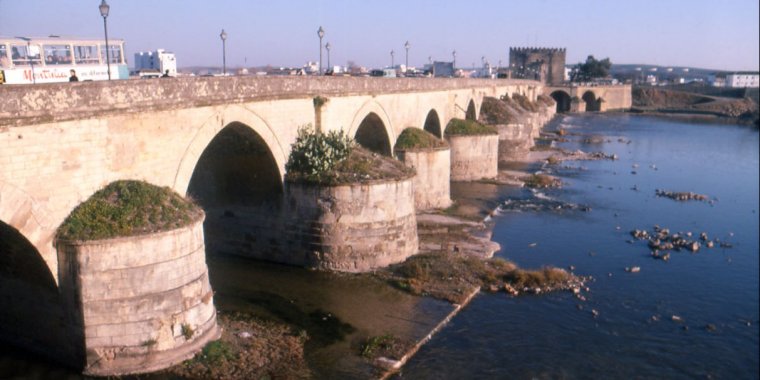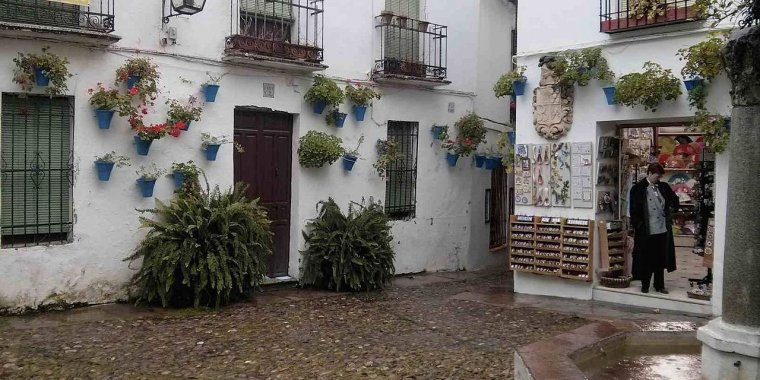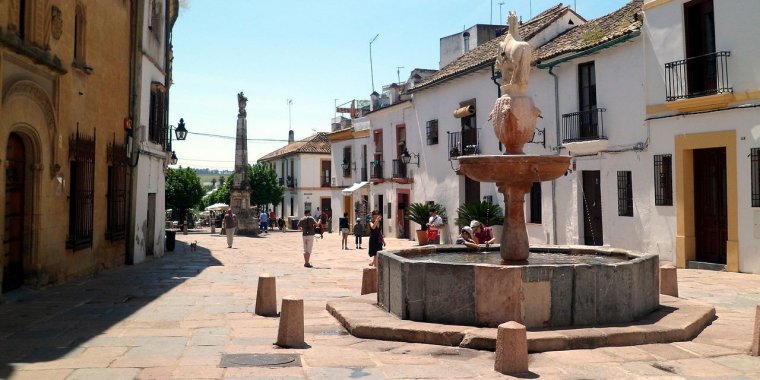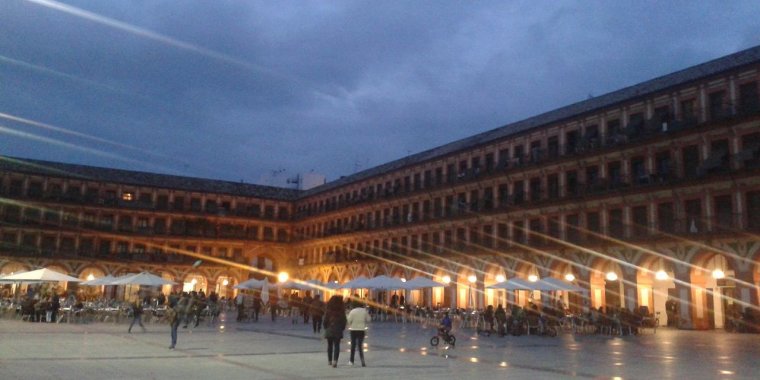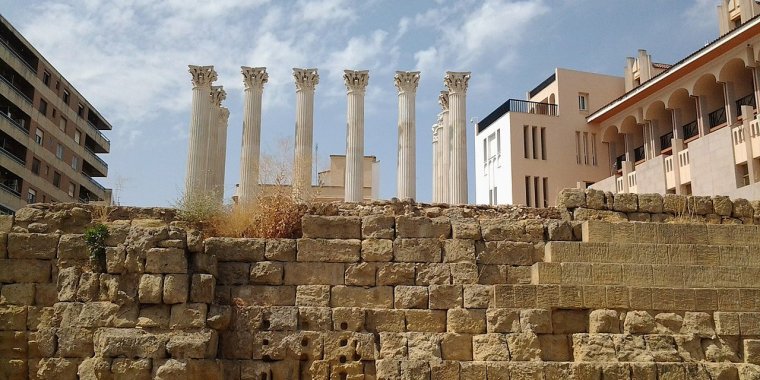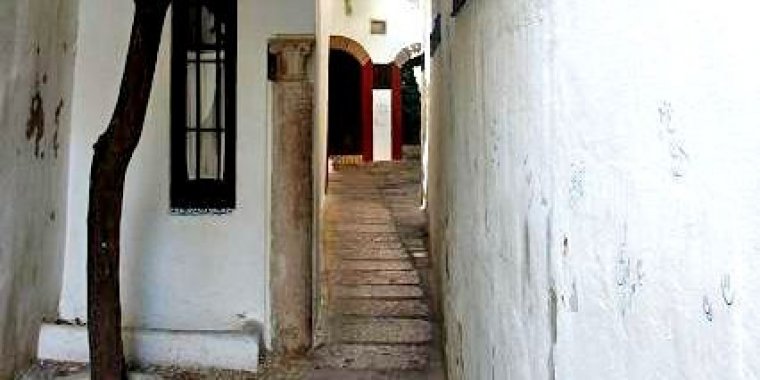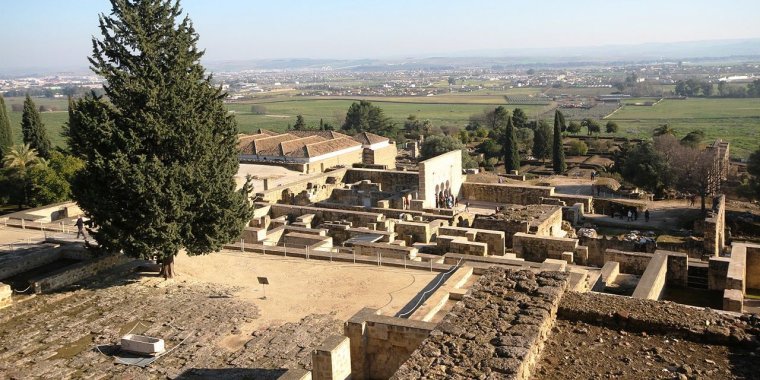| Published in Destinations |
Córdoba, Spain
Very few places in the world can boast of having been the capital of a Roman province (Hispania Ulterior), the capital of an Arab State (Al-Andalus) and a Caliphate. Such splendor is palpable in the intellectual wealth of this city, that has seen the birth of figures like Seneca, Averroes, and Maimonides.
The historic quarter of Córdoba is a beautiful network of small streets, alleys, squares and whitewashed courtyards arranged around the Mezquita, which reflects the city's prominent place in the Islamic world during medieval times.
Córdoba also has much to offer in terms of art, culture and leisure, thanks to a myriad of cultural events that are organized here throughout the year: Flamenco festivals, concerts, ballet and other activities. These events are complemented by a number of museums and a good nightlife scene.
Get in
By train. RENFE, Spain's high-speed rail network, offers a very fast and comfortable train service to Córdoba. From Madrid Atocha trains run hourly, most continuing to Sevilla (45 min), some to Malaga (50 min), Cadiz or Algeciras (for Morocco). Two of the Madrid services originate in Barcelona, taking about five hours via Zaragoza. As the trains are so fast and journey times are short, they only run day-time.
Estación de Córdoba Central, Glorieta de las Tres Culturas. The station is modern, on Avenida de America. There are luggage lockers, wi-fi, cafés, and a tourist information centre. To get to the old town including Mezquita, turn left in the station mall as you exit the platform, then right down the verdant divided boulevard of Avenida de la Republica Argentina. 15 min brings you to a gate through the old city walls, keep straight on then bear right towards the biggest tower in view.
By bus. Córdoba Bus Station (Estación de Autobuses de Córdoba), Avenida de la Libertad (just across the street from the train station). Regular buses from almost every town in Andalucia as well as from Madrid departing from the "Estación Sur" (around 6 buses per day). ALSA and Socibus both have timetable and ticket information online.
By plane. Córdoba has no airport. The closest major airports are in Seville, Málaga and Madrid; from there a train or a bus to Córdoba takes but a few hours.
By car. Distances to Cordoba: Madrid 407 km, Badajoz 278 km, Granada 166 km, Malaga 175 km
Get around
Just about everything of interest in Córdoba is within easy walking distance (the one notable exception being the Medina Azahara), and the typical tourist can do with the standard tourist map which can be obtained from the tourist offices (one on the east side of the Mezquita, another between the Alcázar and the city walls, and yet another in the train station, to name a few).
The area with by far the most to see is the Old City surrounding the Mezquita. The Old City is a tangle of medieval-style streets roughly bounded by the Guadalquivir River on the south, the area surrounding Plaza de las Tendillas on the north and the tree-lined Paseo de la Victoria on the west. This area is crammed with places to stay, eat and buy souvenirs, though many visitors may find certain areas (particularly immediately surrounding the Mezquita) too touristy, with more interesting things found wandering into the tiny streets of the Jewish Quarter to the west and north of the Mezquita. Behind the Mezquita the Roman Bridge crosses the Guadalquivir River to a museum in the old gate on the opposite side.
The area immediately to the north of the Old City, roughly from the area around Plaza de las Tendillas to Avenida de America is a more modern section of town and is where the train and bus station is located as well as a major shopping area. Along Paseo de la Victoria on the west side and Avenida de America on the north are large parks that make for a pleasant stroll.
What to See in Córdoba
• The Mezquita. M-Sa 08:30-19:00, Su 08:30-10:30 and 14:00-19:00 (last entry 30 minutes before closing). €10 (free entry during 8:30-9:30 morning mass).
The biggest attraction in Córdoba and a truly must-see building, the Mezquita is a massive former mosque-turned-cathedral famed for its "forest" of columns topped with Islamic-style red and white striped arches among its other many architectural highlights and serves as a reminder of the glory and importance Córdoba held in medieval times. The building is full of history and beauty - you'll want to give yourself at least a couple of hours to do it justice.
Built in 786 as a mosque, the structure was expanded several times under Córdoba's Muslim rule while still remaining largely true to the original design. Following the Christian Reconquista of Córdoba in 1236, work immediately went underway to convert the building to a church, and four centuries later a cathedral at the center of the building was constructed, though not without controversy as it significantly altered the space. Today, despite the presence of the cathedral, most of the original mosque structure remains remarkably well-preserved.
Approaching the Mezquita, the first thing you will notice is the massive bell tower on the building's north side which looms over the surrounding buildings. Built in the 1600s the tower replaced a minaret previously on the site. Along the outside of the building the wall takes on the appearance of a fortress, with an elaborate set of Moorish-style archway and windows spaced every so often.
Stepping through one of the doors you'll enter the Patio de los Naranjos, or Court of the Orange Trees, which true to its name contains a grove of orange trees, planted in symmetrical rows that replicate the forest of columns within the building. A large fountain drips pleasantly in the middle, and the views of the bell tower framed by trees are excellent. The Patio is free to enter and is open during the day as a public park - the ticket booths are located on the bell tower side of the courtyard.
Entering the interior you'll immediately be standing before the forest of columns which recede into the distance, topped with their dazzling horseshoe arches. The light in the space will play interesting tricks with the arches and varies pretty dramatically as you walk through the building, going from rather dark when you enter to very bright at the cathedral in the middle and back and forth as you continue.
Opposite the room from the entrance is the Mihrab, a spectacular archway decorated with Arabic writing which was the focus of the mosque, as it faced in the direction of Mecca and was what every Muslim faced as they knelt on the floor to pray. Once, tens of thousands of people could fit into this space to pray, the multitude knelt on their rugs before the Mihrab. In the corner of the building nearby are glass cases with artifacts excavated from beneath the Mezquita, and the walls along the side of the building are lined with chapels, each one with an intricate piece of artwork.
At the center of the building, the Cathedral towers over the rest of the building, and the transition from the impressive-but-intimate mosque structure to the overwhelming awe of the cathedral is abrupt and rather jarring, but don't let that stop you from taking in the beauty of the cathedral, with its rich decoration and well-illuminated interior, standing to suggest triumph over the Muslims who previously used this building. The presence of the cathedral also offers the unique opportunity to so easily compare the differences between Muslim and Christian architecture.
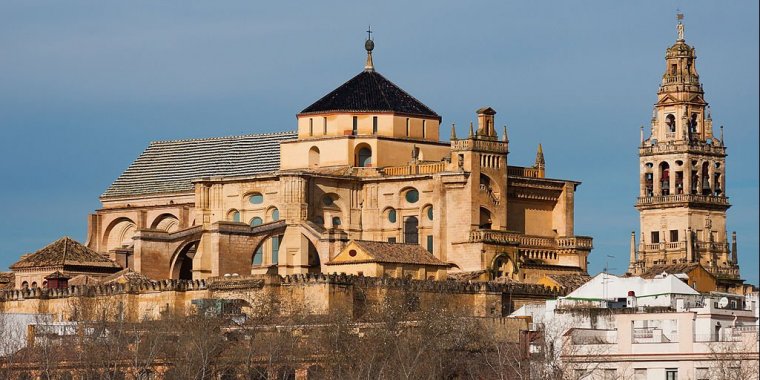
Mosque of Cordoba (la Mezquita-Catedral de Córdoba). ![]()
• The Old City. A tangle of narrow medieval streets surrounding the Mezquita, the Old City sits just uphill from the muddy Guadalquivir River and contains the vast majority of Córdoba's tourist attractions. North and west of the Mezquita sits the Jewish Quarter, a neighborhood which dates from the late Middle Ages and offers an interesting stroll, some lovely patios and a few scant reminders of the Jewish population that once lived here.
• Roman Bridge (Puente Romano). A Roman-style bridge over the shallow Guadalquivir River that was once the main crossing over the river, securing Córdoba's importance to the region. The entrance to the bridge is marked by a triumphal arch and an adjacent single-column monument and it crosses to an old fortified gate on the other side.
• Museum of Al-Andalus Life (Museo Vivo de Al-Andalus), C/ Puente Romano (at the opposite end of the Roman Bridge). October-April 10:00-18:00, May-September, 10:00-14:00 and 16:30-20:30. A history museum located in the Torre de la Calahorra, which once served as the old fortified gate to the city. Upon entering the museum the greeters (who speak good English) have you don a headset which will explain the exhibits and artifacts on Muslim Andalusia you will view as you walk from room to room. The narrators take a very philosophical take on the whole thing and their descriptions of Islam may come off as rather flowery, but the artifacts are worth a look and the balcony on the top of the tower offers an excellent view of the river and the city. €4.50, €3 children.
• Alcazar de los Reyes Cristianos, C/ Caballerizas Reales. Tu-F 08:30-19:30, Sa 09:30-16:30, Su 09:30-14:30. Built in the 8th century as a caliphate residence on the site of a Visigoth fortress, the Alcazar was used as the residence and fortress of Ferdinand and Isabella (the "Christian Monarchs" for whom the building is now named) as well as a headquarters for the Spanish Inquisition. The fortress, with its artifacts (including a series of Roman mosaics and a Roman sarcophagus) and two towers is now open for touring, but the main attraction here is the lush and beautiful gardens on the site. €4.5, students €2.25.
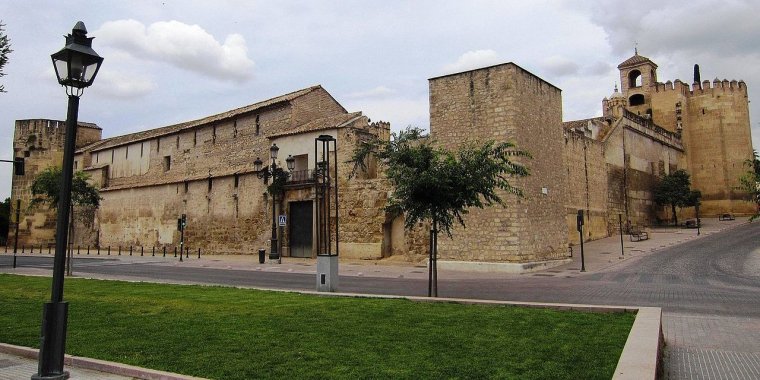
Alcazar de los Reyes Cristianos. ![]()
• Calle de las Flores (near the Mezquita, on the tower side). A beautiful narrow street, full of flowers with a wonderful tiny square at the end and excellent views of the Mezquita's Tower framed by the buildings lining the street.
• Synagogue (La Sinagoga), C/ Judíos (in the Jewish Quarter). Closed to visitors since December 2017, for conservation and rehabilitation. A small but beautifully preserved synagogue - one of only three remaining in Spain - the structure was built in 1315 and consists of a single small, square room with high ceilings and gorgeous Mudejar decorative plaster on the walls. €0.30, but you may find no one staffing the door, in which case it's free.
• Casa de Sefarad.
• City Wall.
• Plaza del Potro - A small old square where Don Quijote de la Macha stayed in one of his adventures. You can find there a nice fountain with a small horse and a 'Triunfo de San Rafael'. Julio Romero de Torres local painter Museum and Fine Arts Museum are also located in this place.
• Plaza de la Corredera - The only 'Plaza Mayor cerrada' (closed main square) in Andalucía.
• Capilla de San Bartolomé, Calle Averroes. 15 Sep – 14 Jun: Tu-Sa 10:30-13:30, 15:30-18:30; Su 10:30-13:30; M 15:30-18:30; closed during summer. A marvelous Gothic-Mudéjar chapel from the 15th century, with beautiful tiles and vaulting. The chapel is maintained by Córdoba University. €2 (Sa, Su and holidays), €1.50 (M-F), free (Córdoba University students).
• Albolafia Water Mill (west of the Puente Romano). A reconstructed Moorish water wheel, and the only one remaining in Spain. Free.
• Templo Romano (Roman Temple of Cordoba), Along Calle Claudio Marcelo. 5-min walk from Cordoba's main square is the Templo Romano, the ruins of Roman temple dating back to the 1st century A.D during the reign of the Emperor Domitian (81-96 CE). The ruins are badly degraded and the columns have been reconstructed, but at night the place is nicely lit up. A family of feral cats at the site attracts as much attention as the ruins themselves. The Templo Romano, Puente Romano and fragments at the Archaeological Museum are all that remain of Cordoba's Roman past. Free.
• Museo Arqueológico (Archaeological Museum of Cordoba), Plaza Jerónimo Páez, 7. 16 Sep-15 June: Tu-Sa 09:00-19:30, Su & holidays 09:00-15:30; 16 June-15 Sep: Tu-Su 09:00-15:30. Small museum tucked away in a plaza in the old city, it showcases artefacts from Cordoba's prehistory, through its Roman and Islamic eras to Medieval times. Most impressive of all, the museum is built over the ruins of Cordoba's old Roman amphitheatre, and allows visitors to walk through the actual ruins. €1.50 (non-EU visitors), free (EU visitors).
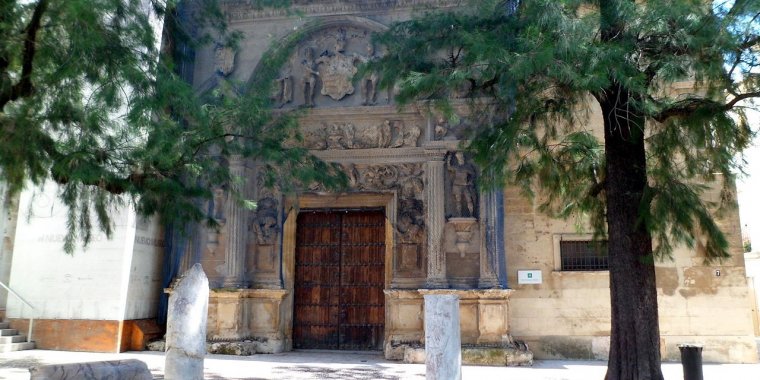
Museo Arqueológico - Palacio de los Paéz Castillejo. ![]()
• Calleja del Pañuelo (Handkerchief Alley), Calleja del Pañuelo. Tiny alleyway near the Mosque-Cathedral. At its narrowest point, it is supposedly only 72 cm wide. Built in the Moorish style, it leads to a small square (smallest in the world) with a fountain.
• Plaza del Cristo de los Faroles, Cuesta del Bailio (Close to Alfaros street). The most impressive square, the best time to go there is the sunset or night. A Christ in the Cross statue adorned with lot of old lanterns, candles and flowers in a very quiet atmosphere. While it is outside the old city - it's really not far.
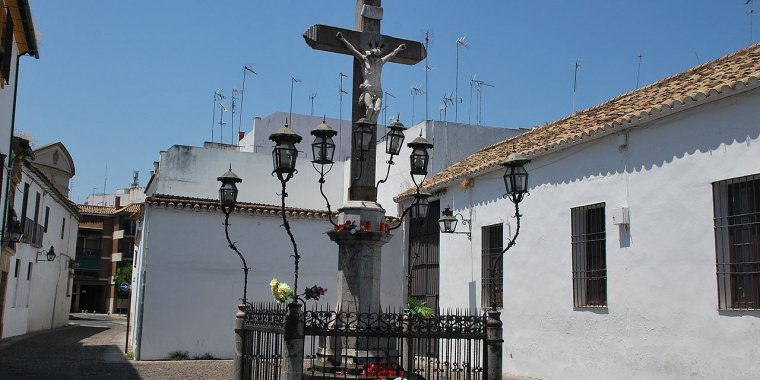
Plaza del Cristo de los Faroles. ![]()
• Plaza de las Tendillas.
• Viana Palace. Former residence of the Marquise of Viana, this is an impressive museum featuring furniture, tapestries, porcelain, tiles, paintings, leatherwork, muskets, a 7000-volume library and extensive gardens spread out over 14 patios.
• Medina Azahara, Carretera de Palma del Rio (Approximately 5km west of town). The tourism office runs a bus at 10:15 or 17:00 for €7. World heritage listed ruins of the capital of the Western Caliphate, built beginning in 940. Huge archeological interest, a beautiful and very special walk. Free entrance for EU-citizens, very cheap for non-EU.
What to Do in Córdoba
• Feria de Córdoba - Last week in May, a huge fair of drinking, dancing, eating, and not working. Flamenco and salsa music.
• Cruces de Mayo - 1st week of May. A lot of public squares in the city center, the old city, with big crosses flower-made, with music and drinks full of people having fun!
• Cata del Vino Montilla-Moriles - Cordovan wine-tasting fair. Very good wine selection, tapas and music in a huge tent in the city center.
• Festival de Patios - About 2 weeks during May. People living in the ancient districts of Córdoba are proud to open their courtyards to visitors and participate in a contest in which colourful plants and different elements invite to contemplate the beauty of traditional style houses.
• Semana Santa (the week before Easter) - Processions throughout town involving scenes from the life of Christ, bands, and penitents. Very nice exhibition of the city's culture. Approximately six processions each night from 18:00 to midnight.
• Festival Internacional de la Guitarra. The city become the world Guitar Capital during two weeks full of concerts featuring the top world guitar players and bands ranging from Jazz/Blues, Classical, and of course, Flamenco. Excellent music and dance seminars, music courses, and conferences about guitar.
• Carnaval A typical Andalusian carnival. The city center is full of people in costumes during the weekend, funny songs are sang throughout city squares.
• Hammam - Arabic baths. 5 minutes walking distance west of the mosque there is a modern Arabic bath that recreates the ones used during the Moorish era. During the golden times of the western caliphate Cordoba was said to have more than 400 baths. The site offers a session of two hours (including a massage).
• Take a Segway Tour in Córdoba, passing by places which are normally missed by the visitor. English spoken tours. From €15 per person.
Shopping in Córdoba
The main shopping area is around the Plaza de las Tendillas: Concepción street, Cruz Conde street, Gran Capitán boulevard, Ronda de los Tejares avenue...
• Sukia - cocktail shop, Cuesta Luján 4. (between Plaza de las Tendillas and San Fernado), 95749051, Really cool shop. Its sells Kitch, be it in clothes, music, decorations form, if it's kitch from the 1950s, 60s or 70s, its here.
• Blas s - Artisanal Ceramics, Calle Martinez Rücker. (The street leading to the Mezquita with a Moroccan restaurant). This store is one of Córdoba's hidden gems. The owners sell beautiful ceramics of various different styles from their patio, so not only do you get to take a look at lovely handmade ceramics, but you also get a feel for the traditional Córdoba patio. If you're not lucky enough to visit Córdoba during the weeks of the patio competition, this store offers you a great opportunity. The ceramics are also of a higher quality than those of most of the stores around the Mezquita, since the store is dedicated to ceramics and isn't tourist-oriented. They are displaying the works of Carlos Durán, a Toledo surrealist with a flare for color.
One of the traditional craftwork in Córdoba is jewellery. Good value jewels, specially gold, can be found around the city. However, it is advisable to buy far from touristic sites as they are the most expensive places to buy that. One place to check it is around Jesus Rescatado avenue.
Restaurants
• Restaurante Casa Rubio, Calle Puerta de Almodóvar, 5. M-Th 13:00-16:30 19:30-23:30, F Sa 13:00-24:00, Su 13:00-23:30. In the heart of the Juderia, this place offers decent tapas for the price. A bit more expensive version of it is next to the mosque, called Casa Pepe de la Juderia, which serves the same food at a slight markup for location.
• Taberna Góngora, Calle del Conde de Torres Cabrera, 4. Daily 12:30-16:00, 19:00-23:30. Popular with locals and well known for their cured meats (carne de monte).
• La Abadia, Avenida. del Aeropuerto, 4. 09:00 - 00:00. It is located along a 'tapas' boulevard popular with the locals for food. Crowded on football game days. Tapas range from 1.70 - 3€.
• Delorean, Calle Alfonso XIII, 2. 08:30-16:00; 20:00-00:30 (Kitchen opens at 12:30). Near the Templo Romano, this place serves free tapas with every drink, with every additional tapa at €1. Their house specialties include Piruleta de Barbacoa (Barbecued meat on a lollipop) and Pulpo a la Gallega (Galician-style cooked octopus). €2-3.50.
• El Caballo Rojo, Calle del Cardenal Herrero, 28 (near the Mezquita). Locals claim it has the best rabo de toro in town. Daily 09:00-24:00.
• Bodegas Campos, Calle Lineros, 32. Daily 13:00-16:00, 20:30-23:00; closed 24 Dec, 31 Dec. Classic Córdoba place to eat. Historic building and famous for people who have visited.
• Casa Mazal, Calle Tomás Conde, 3 (between the mosque-cathedral and the synagogue). Daily 12:00-16:00, 20:00-23:30. This restaurant offers customers a chance to sample traditional Sephardic Jewish cuisine.
• Restaurante Castillo de la Albaida, Carretera De Trassierra, km 3. A refurbished castle in the foothills of the Córdoba Sierra, 10 minutes from city center by car.
• Restaurante El Churrasco, Calle del Romero, 16 (very close to the Mezquita). Daily 13:00-16:00, 20:30-24:00.
• Restaurante Amore Bonapasta, Calle Reyes Católicos, 17. Su-W 13:30-16:00, Th-Sa 13:30-16:00 21:00-00:00.
• Taberna La Fragua, Calleja del Arco, 2 (off C/Tomás Conde). Delicious home made food and traditional cooking. Relaxed atmosphere.
• Taberna La Lechuga, Calle Tomás Conde, 12. Córdoba traditional style food.
• Taberna San Miguel (Casa El Pisto), Plaza de San Miguel, 1 (behind Iglesia de San Miguel). M-Sa 12:00-16:00, 20:00-24:00. Established in 1880.
Bars and Clubs
• Plaza de la Corredera. A lot of bars in this beautiful place, nice environment and nice people.
• Vial Norte (Paseo de Córdoba). A lot of modern bars in the newest part of the city. Cute people and fancy pubs.
• El Brillante el Tablero, Avenida del Brillante. For summertime, fancy bars, fancy people in those rich neighborhoods. From June to September.
• Polígono industrial de Chinales (Chinales, industrial park). Very close to the city center (5-10 min by car, €4 by taxi).
• Ciudad Jardín neighborhood Alderetes street, Julio Pellicer street. A lot of small but very fun places to dance, drink! From October to May.
Hotels and Hostels
• Hostal Lineros 38 A very nice place to relax. Beautiful Andalusí (Islamic from souther Spain) architecture.
• Hostal el Triunfo Cheap and quite nice hostel in from of the Mezquita.
• The Terrace Backpackers (aka Pension Pilar del Potro / Funky Córdoba), Calle Lucano, 12. Good location. Clean privates and dorms. Air-conditioning. Strangely has three separate names.
• Séneca Hostel, C/ Conde y Luque, 7. Kitchen, wi-fi.
• Backpacker Al-Karte, C/ Martínez Rucker, 14 (near the Mezquita-Catedral). Built in a traditional Andalusian house, with an open courtyard as the centre of the hostel. It has private rooms for parties as large as six to six-bed dorm rooms. Pleasant environment and friendly owner who will go all out of the way to give advice on what to see in Córdoba.
• Hotel Maciá Alfaros. Great hotel with old town central location. Walking distance to central plaza, shopping, archeology sites, drinks.
• Hotel Los Abetos Cordoba, Av. de San José de Calasanz, 2 14012 Córdoba Córdoba.
• Hotel AC Córdoba Excellent hotel in a modern environment set a block from the bus and train stations, very close to the city center.
• Hotel Córdoba Center The newest hotel in the city, 5 minutes walking distance from Train/Bus station and city center.
• Hotel Hospes Palacio del Bailío, the only 5-star hotel in town. Centrally located. Incredible old city palace from the 16th century. Respecting both Roman and Moorish architectural influences. 53 rooms, restaurant and spa. The new essence of Hospes Palacio del Bailío tells an old story, its architecture speaks of history in the old quarter of the city, next to the Cristo de ls Faroles square and 10 minutes from the Mosque.
• Hotel Mezquita, Plaza Santa Catalina, 1 (on the eastern side of the Mezquita). Check-in: 13:00, check-out: 12:00. Next to the Mezquita, this is good value with friendly service. Free wi-fi, luggage storage available.
• Hotel NH Amistad, Plaza de Maimónides, 3. In the heart of the old town, 5 minutes walking from the Mezquita. Settled in the old city walls, inside a beautiful palace. There is another NH hotel right next door - the NH Califa.
• Hotel casas de la Judería, Calle Tomás Conde, 10. Renovated historic 4-star hotel near the Mezquita Cathedral.
Tourist Info
• Tourist Information Office (Punto de Información Turística), Plaza de las Tendillas, 5. Daily 09:00-14:00, 17:00-19:30.
• Tourist Information Office (Punto de Información Turística), Campo Santo de los Mártires (in front of the Alcázar). Daily 09:00-14:00, 17:00-19:30.
Exercise caution when walking around the area near the Mezquita: beggars will try to sucker you for some money and they often work in teams. You may find yourself being charged €40 for a palm reading, or having your money snatched by a little kid working together with the supposed palm reader. Just keep an eye on your things and don't get caught up with their scams.
Go next
Outside the city are very beautiful villages with longstanding traditions and ancient monuments. Many of them are served by the intra-province buses at Cordoba bus station. Some examples are:
• Priego de Córdoba. 103km southeast of Cordoba, Priego de Cordoba is filled with numerous Arabic, Spanish Baroque and Neoclassical monuments. Some remarkable monuments are the Fuente del Rey (The King's Fountain, built in Spanish Baroque style) with its 139 water spouts, the castle and the town's villa (all of Arabic origin) and the Castilian Playground (a 16th-century garden). The town is also known for its cuisine — in particular, its revuelto de collejas (campion [a type of flower] scramble) and medallones de rabo de toro (oxtail medallions).
• Zuheros. 76 km southeast of Cordoba, Zuheros is a typical white Andalusian village with an impressive Moorish castle built on a rock. 4 km from the town lies the Cueva de los Murciélagos (Cave of the Bats), a huge cave worth the visit for geological and archaeological fans. It contains Neolithic art, and has impressive stalactites and stalagmites. The village itself is famous for its goat cheese.
• Montilla. 44 km south of Cordoba, Montilla is world famous for its Montilla-Moriles wines and sherry. It is also known for its bakeries and its Holy Week procession.
• Montoro. 45 km northeast of Cordoba, Montoro is a picturesque town built on a bend on the Rio Guadalquivir. It is known for its historic quarter and its bridges. It is also the gateway to the Cardeña-Montoro Nature Reserve.
• Baena. 62 km southeast of Cordoba, Baena is where Andalucia's best olive oil is produced.
• Bujalance. 42 km east of Cordoba (an hour by bus), Bujalance is home to the second tallest structure in the province after Seville's Giralda- the slightly-leaning clocktower of the Nuestra Señora de la Asuncion church - and a Moorish fortress.
• Parque Nacional de la Sierra de Hornachuelos in Hornachuelos and Parque Natural de las Sierras Subbéticas in Cardeña are interesting nature reserves. (Wikivoyage)
See also Córdoba in Pictures
YOU MAY ALSO LIKE
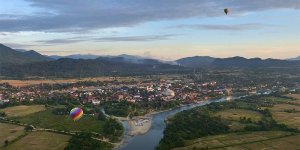





 If you own or manage a travel-related business such as a hotel, a bed-and-breakfast, a restaurant, a pub or a cafeteria, you can create a web page for your business for free on Titi Tudorancea Travel Info. » |

